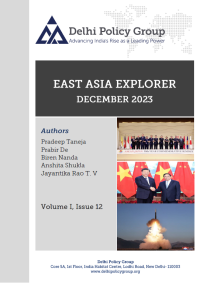East Asia Explorer
Date: January 07, 2024
The East Asia Explorer tracks evolving geopolitical trends, emerging security challenges, and progress towards regional integration in East Asia. It focuses on the ASEAN grouping, domestic and foreign policy developments in countries of East Asia and Oceania, great power contestation in the region, and India’s relations with ASEAN and its member countries.
In this issue, Dr. Pradeep Taneja examines the outcomes of Chinese President Xi Jinping’s first state visit to Vietnam in six years and the current nature of bilateral relations between China and Vietnam, as the latter elevates security relations with other great and middle powers in quick succession.
Dr. Prabir De reviews the current economic engagements of South Korea and India with the ASEAN and presents an overview of the potential for the next round of collaboration between them. He outlines the need for and scope of collaboration between the two countries under India’s ‘Act East Policy’ and South Korea’s ‘New Southern Policy’ Plus (NSPP). He also highlights the role of maritime cooperation between India, South Korea, and the ASEAN in reshaping the Indo-Pacific integration process.
Ambassador Biren Nanda analyses and identifies key strategic drivers behind India’s ‘Act East Policy’. He answers some pertinent questions in his piece: What are the unique characteristics of the current situation in Asia? What is the background to current relations between India and Southeast Asia? What were the enabling factors behind India’s Look East Policy? What is the strategic significance of the coming together of ten ASEAN countries and India in the Dialogue Partnership? What has been the progress of India’s Dialogue Partnership with ASEAN? And finally, how do we distinguish between the Modi Government’s ‘Act East Policy’ and its predecessor, the ‘Look East Policy’ adopted in 1991?
Jayantika Rao analyses the destabilising events that have occurred in the Korean Peninsula in the recent past. She sheds light on the these developments, which include intercontinental ballistic missile testing and reconnaissance satellite launches by North Korea, as well as the deepening of coordination between the US, South Korea, and Japan. In addition, she discusses their implications and potential consequences on the political and economic landscape of the region.
Finally, Anshita Shukla reviews the recently concluded ASEAN-Japan Commemorative Summit marking the 50th Year of ASEAN-Japan Friendship and Cooperation in Tokyo. She highlights the outcomes of the summit and Japan’s bilateral meetings convened on the sidelines of the summit. The author traces the reasons behind the shift in Japan’s engagement with Southeast Asia from economic and development cooperation to include security assistance.
To read this East Asia Explorer, Vol. I, Issue 12, please see the PDF.
In this issue, Dr. Pradeep Taneja examines the outcomes of Chinese President Xi Jinping’s first state visit to Vietnam in six years and the current nature of bilateral relations between China and Vietnam, as the latter elevates security relations with other great and middle powers in quick succession.
Dr. Prabir De reviews the current economic engagements of South Korea and India with the ASEAN and presents an overview of the potential for the next round of collaboration between them. He outlines the need for and scope of collaboration between the two countries under India’s ‘Act East Policy’ and South Korea’s ‘New Southern Policy’ Plus (NSPP). He also highlights the role of maritime cooperation between India, South Korea, and the ASEAN in reshaping the Indo-Pacific integration process.
Ambassador Biren Nanda analyses and identifies key strategic drivers behind India’s ‘Act East Policy’. He answers some pertinent questions in his piece: What are the unique characteristics of the current situation in Asia? What is the background to current relations between India and Southeast Asia? What were the enabling factors behind India’s Look East Policy? What is the strategic significance of the coming together of ten ASEAN countries and India in the Dialogue Partnership? What has been the progress of India’s Dialogue Partnership with ASEAN? And finally, how do we distinguish between the Modi Government’s ‘Act East Policy’ and its predecessor, the ‘Look East Policy’ adopted in 1991?
Jayantika Rao analyses the destabilising events that have occurred in the Korean Peninsula in the recent past. She sheds light on the these developments, which include intercontinental ballistic missile testing and reconnaissance satellite launches by North Korea, as well as the deepening of coordination between the US, South Korea, and Japan. In addition, she discusses their implications and potential consequences on the political and economic landscape of the region.
Finally, Anshita Shukla reviews the recently concluded ASEAN-Japan Commemorative Summit marking the 50th Year of ASEAN-Japan Friendship and Cooperation in Tokyo. She highlights the outcomes of the summit and Japan’s bilateral meetings convened on the sidelines of the summit. The author traces the reasons behind the shift in Japan’s engagement with Southeast Asia from economic and development cooperation to include security assistance.
To read this East Asia Explorer, Vol. I, Issue 12, please see the PDF.



